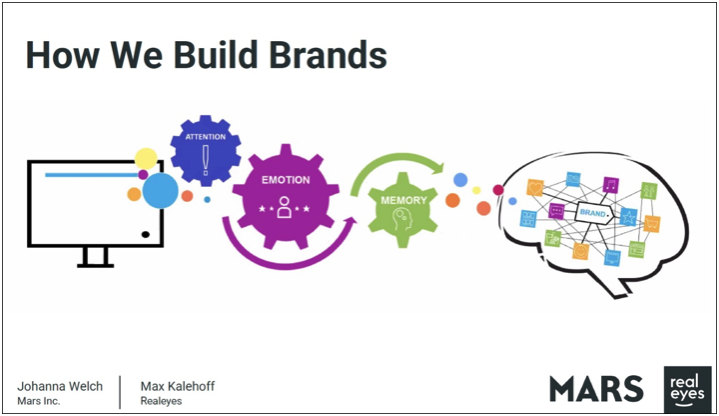Coca-Cola’s Metrics Framework
In a presentation with attention measurement company Adelaide, Greg Pharo described Coca-Cola’s framework for brand communication. Read more »
In a presentation with attention measurement company Adelaide, Greg Pharo described Coca-Cola’s framework for brand communication. Read more »
Attention, Emotion and Memory (ESG) are seen as the key elements in building brands.

The “Attention Break-out Session” during the second day of the AUDIENCExSCIENCE conference showed that attention metrics are typically used within a larger framework. Case in point, a presentation by Realeyes and Mars showed how Mars sees attention to marketing messages as a trigger of emotions that leads to memory and (hopefully) brand building.
Source:
AUDIENCExSCIENCE Break-out Session, Attention Metrics: Validity, Reliability & Predictive Powers. Using Attention AI to Predict Real-World Outcomes – Max Kalehoff, VP Marketing Growth, Realeyes; -Johanna Welch, Global Mars Horizon Comms Lab Senior Manager, Mars.
Spencer Lambert – Director, Product & Partnership Success, datafuelX
Matt Weinman – Senior Director of Product Management, Advanced Advertising Product, TelevisaUnivision
Key Takeaways
Brendan Kroll – VP Performance Measurement, Nielsen
Anne Ori – Measurement Lead, CG&E, Google
Daniel Sacks – Incrementality Lead, US Agency, Google
Key Takeaways
Souptik Datta, Ph.D. – Sr. Director, Data & Analytics Services, GroupM
Michael Siewert – Programmatic Director, Colgate-Palmolive Co.
Michael Siewert (Colgate-Palmolive) and Souptik Datta (GroupM) presented how their companies worked together to combine measurement data for building custom solutions around bidding in the programmatic space. Colgate wanted to create their own quality definition for their inventory and be able to benchmark at a scalable cost benefit. Building a framework around their definition of quality and creating their own “qCPM” metric allowed them to understand the details of performance at a baseline and optimize with machine learning across 80+ markets and varying formats.Key Takeaways: Mapping their quality journey involved
The ARF hosted its annual flagship conference, AUDIENCExSCIENCE 2023, on April 25-26, 2023. The industry’s biggest names and brightest minds came together to share new insights on the impact of changing consumer behavior on brands, insights into TV consumption, campaign measurement and effectiveness, whether all impressions are equal, join-up solutions across multiple media, the validity, reliability and predictive power of Attention measures, targeting diverse audiences, privacy’s effect on advertising and the impact of advertising in new formats. Keynotes were presented by Tim Hwang, author of Subprime Attention Crisis, Robert L. Santos of the U.S. Census Bureau, Brian Wieser of Madison and Wall, LLC and Andrea Zapata of Warner Bros. Discovery.
Member Only AccessMarc Pritchard, P&G’s Chief Brand Officer, described a new focus for his company’s advertising strategy.
We’ve all heard about the growing use of artificial intelligence in advertising research and doom and gloom predictions that it will knock out jobs, but is this really the case? Agency leaders joined us for an ARF Town Hall to discuss the upsides and possible downsides of generative AI, as well as how they’re utilizing it in their businesses to boost efficiency. Attendees heard predictions on how AI will change the business model of advertising and what it could mean for media agencies.
We asked the chatbot: “How do you make effective advertising?” The answer surprised us.
The boldest and brightest minds joined us November 14 - 17 for Attribution & Analytics Accelerator 2022—the only event focused exclusively on attribution, marketing mix models, in-market testing and the science of marketing performance measurement. Experts led discussions to answer some of the industry’s most pressing questions and shared new innovations that can bring growth to your organization.
Member Only Access